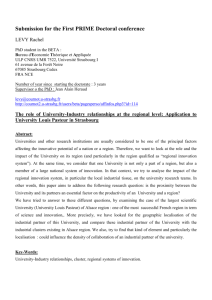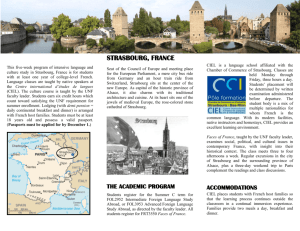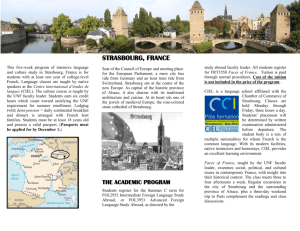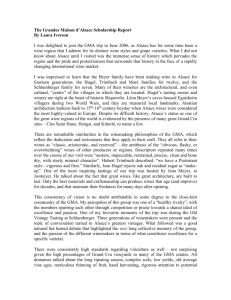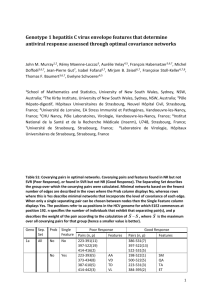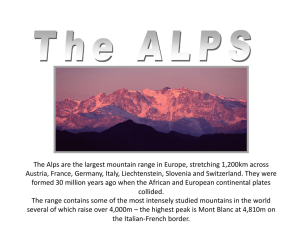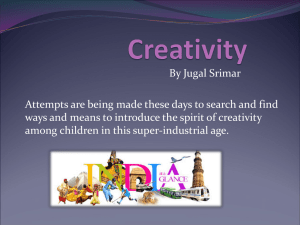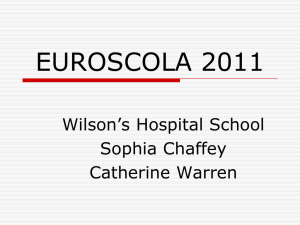HEC Montreal Summer school Management of Creativity in an
advertisement
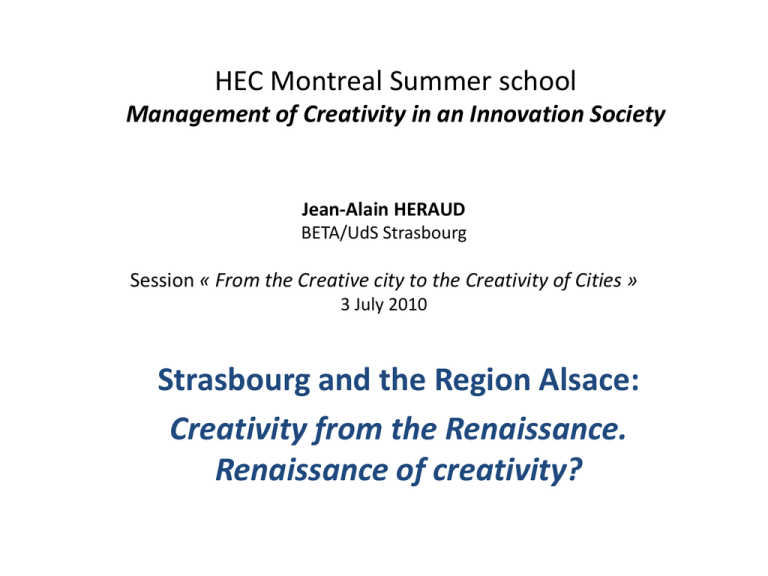
HEC Montreal Summer school Management of Creativity in an Innovation Society Jean-Alain HERAUD BETA/UdS Strasbourg Session « From the Creative city to the Creativity of Cities » 3 July 2010 Strasbourg and the Region Alsace: Creativity from the Renaissance. Renaissance of creativity? Identity (ies) ? L’Alsace s'Elsàss dasElsaß Strasbourg Stràsburi Straßburg What is Alsace? 1. One of the 22 French « Regions » (metropolitan France) Traditionnally industry-oriented, but recently evolving towards tertiary activities What is Alsace? 2. An area geographically and historically rooted in the Upper Rhine Valley History Tradition of creativity and innovation in the Upper-Rhine area Johannes GUTENBERG Born: Mayence (Mainz) around 1400 Has worked in Strasbourg ********************** Religion: protestantism Litterature: Sebastian Brandt Painting, Architecture, etc. Where is Alsace? 3. Institutionally at the heart of Europe: European Parliament in Strasbourg plus many other European institutions: Council of Europe Europ. Court of Human Rights Assembly of European regions Etc…. European Parliament in Strasbourg What is Alsace? 4. A future transborder European region? Institutional projects with neighbouring German and Swiss regions: Upper-Rhine as a « Small Europe » Exemples: * EUCOR (Universities) * Regional Trinational Metropolitan Region (Rhin Supérieur/Oberrhein) Conseil rhénan Eurodistrict Strasbourg-Ortenau Upper Rhine: Europe’s R&D and Education golden triangle 167,000 students 20,000 researchers Highest concentration of R&D in Europe Region of excellence with numerous research centers and start-ups Regional mapping of the « economics of knowledge » in Europe Share of knowledge workers 2006 9 TMR Upper Rhine: Science and Research Map Many institutions in the Upper Rhine: - 9 Universities and 64 further institutions of higher education and applied sciences with about 167'000 students - 43 institutions in the area of technology transfer and innovation promotion - 21 institutions for environmental, agricultural science and energy - 14 Life Sciences institutions + EUCOR - European Confederation of the Upper Rhine Universities A world-known trinational cluster in life sciences As a unique project established in the heart of Europe, bringing together Alsace in France, South Baden in Germany and Northwest Switzerland, with as centers Strasbourg, Freiburg and Basel, BioValley was one of the first European initiatives for the promotion and the development of life sciences. It has grown to become one of the leading life sciences regions in the world. The TMR ambition The common decision of the stakeholders of the Tri-national Metropolitan region Upper-Rhine: “To become the most dynamic knowledge-based transnational economic area of Europe by 2020 ” A laboratory for the implementation of the Europe 2020 strategy Upper-Rhine area: opportunities and difficulties • Volume and variety of the local endowment (science, technology, culture, …) is a potential for innovation but not a sufficient condition. • Critical mass means interlinking assets. • Variety of institutions, cultures and languages is an advantage in terms of evolutionary models, but it increases transaction costs in the short run! Issues and challenges: 1. Distributed academic strengths Not one big university but several « universities of excellence » along the Rhine. Issues and challenges: 2. Critical mass for knowledge-based activities: The case of KIBS (business services) Issues and challenges 3. Critical mass for activities in typical creative industries Indicators of centrality (large urban agglomerations) Paris, London: class 1 ….. Strasbourg: class 5 Ranking on 15 indicators Issues and challenges specially for Alsace Alsace has some typical characteristics of the Upper-Rhine area : strong middle-tech industry, not enough creativity-based activities. It definitely has a cultural and sociological identity but it is not a full-fledged regional innovation system (RSI coherence problem) Alsace facing its future Issues and challenges specially for Alsace Economic development should not be restricted to traditional industry - even if relatively dynamic and successful, partly following the strong SME model of « Mittelstand », typical of tneighbouring German regions Issues and challenges specially for Alsace Culture-based activities should not be restricted to touristic attractions -even if quality of life is part of the attractivity and therefore of creativity Conclusion Art et culture Economie et technologie Science et éducation 20
